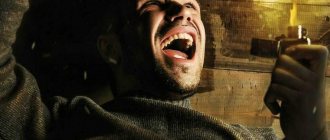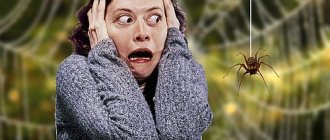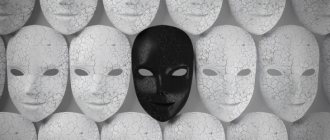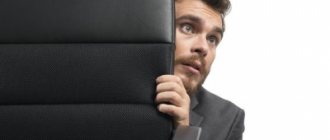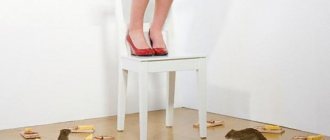Definition of body dysmorphic disorder
A pathological fear of being photographed is diagnosed in those who are critical of their appearance. There are no signs of obvious deformity in their appearance. These unfortunate people live in their own depressive world. They are afraid to even look in the mirror. People who are afraid to be photographed consider themselves unattractive and avoid social contacts because they do not want to be ridiculed in society.
They are afraid of photographs that someone may not like, rarely admit their weaknesses and do not seek help from specialists.
Such people become depressed and suicidal.
Everyone is dissatisfied with their appearance: they want to reduce their nose, get rid of a double chin or become slimmer. It `s naturally. If dissatisfaction with oneself becomes the cause of depression, fear, panic, isolation, then a phobia can be assumed. It prevents a person from enjoying life. A psychotherapist will help you cope with the painful condition, and in severe cases, a psychiatrist.
Suspiciousness is a sign of dysmorphophobia
Fears (phobias, simple phobias) are, as it were, an integral part of the personality’s anxious-suspicious structure and represent a fear of any objects, animals, insects:
- Aichmophobia - fear of sharp objects,
- arachnophobia - fear of spiders,
- herpetophobia - fear of snakes,
- Glenophobia - fear of a doll's gaze,
or special situations:
- agoraphobia - fear of open spaces,
- anthropophobia – fear of people, crowds, incl. syphilophobia,
- stroke phobia,
- heart attack phobia,
- cancerophobia,
- cardiophobia,
as well as pantophobia - an all-encompassing obsessive fear.
Some of them, such as agoraphobia, are separated into separate diagnostic categories, while others are combined into a group of simple phobias.
The diagnosis of simple phobia is usually made after excluding agoraphobia and social phobia. A simple phobia, as a rule, is not accompanied by a vegetative complex, although suddenly finding yourself in a phobic situation can provoke a panic attack.
Course and prognosis.
Phobias can be observed in a wide variety of nosological units - from neurotic reactions to schizophrenia. The prognosis in each case is determined individually and directly depends on the nosological form - phobias can either disappear, or gradually be compensated, or, on the contrary, progress (mainly within various forms of schizophrenia).
Treatment.
Of the pharmacological drugs for phobias, benzodiazepine (especially triazole) tranquilizers and beta-adrenergic receptor blockers are most often used, less often serotonergic and tricyclic antidepressants, reversible MAO inhibitors.
Among the psychotherapeutic techniques, behavioral and rational psychotherapy, as well as neurolinguistic programming, are mainly used.
Causes of fear
The cause of fears is most often dysmorphophobia (dysmorphia) - a mental disorder in which a person is fixated on some flaw or feature of his body. This feature is usually invisible to others, but because of this individual trait he developed complexes. He is afraid of filming and deliberately avoids it. A person believes that his shortcomings will be visible on film and everyone will laugh at him.
A person with this phobia experiences fear at the sight of a camera and asks to put it away.
Sometimes a painful condition occurs against the background of excessive modesty. A person does not like to be seen, avoids noisy companies, and becomes embarrassed in an uncomfortable situation. Most often, these complexes are characteristic of introverts or people suffering from social phobia.
There are people who believe that a portrait can bewitch a person, put the evil eye on him, cause damage and even destroy him. This is the esoteric cause of fear.
Famous actors avoid filming because they don’t want everyone to know about their personal life.
Symptoms of autogonistophobia
A person may be afraid of cameras for various reasons, but the symptoms will be the same for everyone:
- redness of the skin of the face;
- noise in ears;
- tachycardia;
- increased blood pressure;
- dizziness;
- dry mouth;
- numbness in front of the camera;
- fear of taking another breath;
- tightness.
Religious Beliefs
In many religions it is natural to deny everything that brings pleasure not only carnal, but also spiritual. And in some beliefs, it is widely believed that the camera is capable of taking away the soul. Christianity also preached the idea that the video camera was controlled by the devil, so it was forbidden to photograph churches, ministers, or small children. Photography was allowed only from the age of 16.
By the way, all kinds of programs about hereditary witches, psychics and other “superhumans”, like the “Battle of Psychics,” contribute to the appearance of this kind of phobia in overly susceptible, gullible individuals. Stories about causing damage based on photos will bring horror to anyone. Moreover, such topics are discussed on forums, and you can even find entire articles with a detailed description of black magic rituals that can drive a person to the grave.
Fraud on social networks
Today, technology allows you to carry out any operations on the Internet with photographs. This can be clearly seen in the examples of photos of stars, for whom the paparazzi are constantly waiting to take a bad photo and expose the person in an unsightly light. Many people are beginning to be afraid to take pictures, because enemies can easily get photos from social networks, process them and post them on porn sites, and then publicly disgrace them.
Of course, fake pictures can be checked, but still, such an incident takes a serious toll on self-esteem and can ruin your entire career or admission to college, not to mention your reputation in a small town or village.
Types of dysmorphophobia
Experts distinguish two types of painful conditions: muscle dysmorphophobia and penile dysmorphophobia. These mental disorders vary, but have much in common.
Characteristics of the species:
Muscle dysmorphophobia, according to some experts, is the opposite of anorexia. People with this phobia believe that their physical fitness is less than ideal. They are obsessed with constantly improving their body - they spend all their free time in the gym, and are obsessed with enhanced nutrition. For such people, skipping a workout means cheating on yourself. Bodybuilders often suffer from this phobia. They try to hide their “imperfect” body under loose clothes and work out intensely. A painful condition can be successfully treated if it is not advanced and the patient is aware of his problem.
Reluctance to show imaginary shortcomings
The term “penile dysmorphophobia” has recently appeared in the dictionary of andrologists. This is due to the fact that there are more people who are unhappy with the shape, appearance or size of the external genitalia. Among these patients there are also women who do not like the appearance and size of the labia minora. Penile dysmorphophobia is not included in the classification of mental and behavioral disorders adopted by the World Health Organization. This term is taken from clinical psychiatry. It denotes a painful attitude towards a real, but small defect, which even specialists may not notice if you deliberately do not pay attention to it. Fears about their appearance prevent such patients from living a full life. A phobia can cause dysmorphomania, and this is a serious deviation.
People with this phobia try to hide from everyone, hide at home. They are afraid that others will notice their imagined inferiority.
Body dysmorphomania
Dysmorphophobia and dysmorphomania - these mental disorders have the same causes, but the second disorder is more serious. The patient’s belief in the presence of a physical defect is delusional and cannot be completely cured. Delusional dysmorphomania may indicate the onset of schizophrenia and manifests itself as an obsessive belief in the presence of an imaginary or extremely aggravated physical defect in visible parts of the body (nose, ears, lips, mouth, etc.). The painful condition is accompanied by delusional ideas, hallucinations, signs of mental automatism, panic fear, etc. Psychotherapists call criticism or name-calling in childhood the main cause of dysmorphomania.
Signs of a painful condition:
- gloomy mood;
- desire to hide true feelings;
- desire to correct physical defects.
Patients convince doctors that they are right. They use the services of plastic surgeons.
Plastic surgery for dysmorphomania
Even the most successful surgical intervention does not bring relief - they continue to suffer. This is manifested by a state of increased anxiety, panic attacks, signs of persistent depression and thoughts of suicide.
An obsession with correcting an imagined flaw forces a person to undergo a series of plastic surgeries. There are cases where patients themselves removed defects or inserted implants, putting their health at risk. Specialists must distinguish between body dysmorphomania and other mental disorders: schizophrenia, pre- and postoperative depression.
Treatment of the disease
Self-treatment of dysmorphophobia does not produce results. The specialist must analyze the causes of the painful condition and choose the most appropriate methods and methods of treatment. First, it is necessary to eliminate the original sources of the problem, i.e. mental disorders. Here you need the help of a psychotherapist or psychiatrist, who will help even introverts open up.
Experienced photographers will also help you overcome this painful condition. They are able to photograph a person so that his imaginary and real shortcomings will not be noticeable. The professional simply will not take pictures that the patient does not like. As a result, the person will no longer be afraid of the camera and will not react painfully to it.
It is easier to prevent the development of a painful condition. During adolescence, a person begins to be critical of his appearance and notice all the shortcomings. Parents should explain to children that every person has a unique appearance. Then they will not face dysmorphophobia syndrome.
What poses to choose to hide your fear of the camera
Usually in the first 20 minutes of a photo shoot it can be difficult to relax, so “closed poses” can be played up artistically:
- Have the model stand holding the back of the chair.
Or sit on a chair, leaning on its back.
- You can aesthetically raise the collar to cover your face or let your hair down beautifully.
- Instead of crossing your arms on your chest or stomach, you can press a prop to your body - a soft toy, a bouquet, a pillow, which will distract you a little, this will reduce the degree of tightness.
- Someone smaller in the frame will help the model to relax, so you can involve animals and children. It's better to take pictures while sitting.
To look more confident in front of the camera while sitting, you can cross your legs and choose figure-correcting poses.
Modesty has its own aesthetics.
